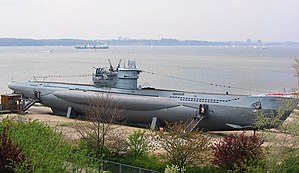German submarine U-1171
 U-995 Type VIIC/41 at the Laboe Naval Memorial. This U-boat is almost identical to U-1171.
| |
| History | |
|---|---|
| Name | U-1171 |
| Ordered | 16 July 1942 |
| Builder | Danziger Werft AG, Danzig |
| Yard number | 143 |
| Laid down | 5 May 1943 |
| Launched | 23 November 1943 |
| Commissioned | 22 March 1944 |
| Fate | Surrendered, 9 May 1945 |
| General characteristics | |
| Type | Type VIIC/41 submarine |
| Displacement |
|
| Length |
|
| Beam |
|
| Height | 9.60 m (31 ft 6 in) |
| Draught | 4.74 m (15 ft 7 in) |
| Installed power |
|
| Propulsion |
|
| Speed |
|
| Range |
|
| Test depth |
|
| Complement | 44-52 officers & ratings |
| Armament |
|
| Service record | |
| Part of: |
|
| Commanders: | |
| Operations: | No patrols |
| Victories: | None |
German submarine U-1171 was a Type VIIC/41 U-boat of Nazi Germany's Kriegsmarine during World War II.
She was ordered on 16 July 1942, and was laid down on 5 May 1943, at Danziger Werft AG, Danzig, as yard number 143. She was launched on 23 November 1943, and commissioned under the command of Oberleutnant zur See Otto Heinrich Nachtigall on 22 March 1944.[3]
Design[]
German Type VIIC/41 submarines were preceded by the heavier Type VIIC submarines. U-1171 had a displacement of 769 tonnes (757 long tons) when at the surface and 871 tonnes (857 long tons) while submerged. She had a total length of 67.10 m (220 ft 2 in), a pressure hull length of 50.50 m (165 ft 8 in), an overall beam of 6.20 m (20 ft 4 in), a height of 9.60 m (31 ft 6 in), and a draught of 4.74 m (15 ft 7 in). The submarine was powered by two Germaniawerft F46 four-stroke, six-cylinder supercharged diesel engines producing a total of 2,800 to 3,200 metric horsepower (2,060 to 2,350 kW; 2,760 to 3,160 shp) for use while surfaced, two SSW GU 343/38-8 double-acting electric motors producing a total of 750 metric horsepower (550 kW; 740 shp) for use while submerged. She had two shafts and two 1.23 m (4 ft) propellers. The boat was capable of operating at depths of up to 230 metres (750 ft).[4]
The submarine had a maximum surface speed of 17.7 knots (32.8 km/h; 20.4 mph) and a maximum submerged speed of 7.6 knots (14.1 km/h; 8.7 mph). When submerged, the boat could operate for 80 nautical miles (150 km; 92 mi) at 4 knots (7.4 km/h; 4.6 mph); when surfaced, she could travel 8,500 nautical miles (15,700 km; 9,800 mi) at 10 knots (19 km/h; 12 mph). U-1171 was fitted with five 53.3 cm (21 in) torpedo tubes (four fitted at the bow and one at the stern), fourteen torpedoes or 26 TMA or TMB Naval mines, one 8.8 cm (3.46 in) SK C/35 naval gun, (220 rounds), one 3.7 cm (1.5 in) Flak M42 and two 2 cm (0.79 in) C/30 anti-aircraft guns. The boat had a complement of between forty-four and fifty-two.[4]
Service history[]
On 9 May 1945, U-1171 surrendered at Stavanger, Norway, before participating in any war patrols. She was later transferred to Lisahally on 27 May 1945. U-1171 would be spared, for a time, becoming a British N-class submarine, N19, used for testing and then in April 1949, broken up at Sunderland.[3]
See also[]
- Battle of the Atlantic
References[]
- ^ Helgason, Guðmundur. "Otto Heinrich Nachtigall". German U-boats of WWII - uboat.net. Retrieved 29 March 2016.
- ^ Helgason, Guðmundur. "Hermann Koopmann". German U-boats of WWII - uboat.net. Retrieved 29 March 2016.
- ^ a b Helgason, Guðmundur. "U-1171". German U-boats of WWII - uboat.net. Retrieved 29 March 2016.
- ^ a b Gröner 1991, pp. 43–44.
Bibliography[]
- Busch, Rainer; Röll, Hans-Joachim (1999). German U-boat commanders of World War II : a biographical dictionary. Translated by Brooks, Geoffrey. London, Annapolis, Md: Greenhill Books, Naval Institute Press. ISBN 1-55750-186-6.
- Busch, Rainer; Röll, Hans-Joachim (1999). Deutsche U-Boot-Verluste von September 1939 bis Mai 1945 [German U-boat losses from September 1939 to May 1945]. Der U-Boot-Krieg (in German). Vol. IV. Hamburg, Berlin, Bonn: Mittler. ISBN 3-8132-0514-2.
- Gröner, Erich; Jung, Dieter; Maass, Martin (1991). U-boats and Mine Warfare Vessels. German Warships 1815–1945. Vol. 2. Translated by Thomas, Keith; Magowan, Rachel. London: Conway Maritime Press. ISBN 0-85177-593-4.
- German Type VIIC/41 submarines
- U-boats commissioned in 1944
- World War II submarines of Germany
- 1943 ships
- Ships built in Danzig